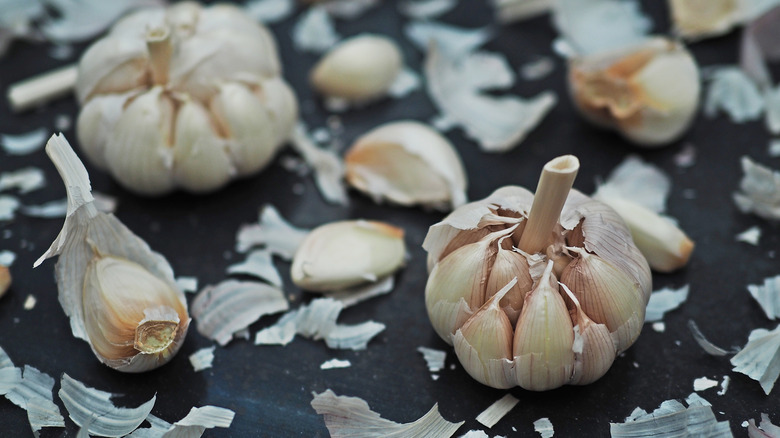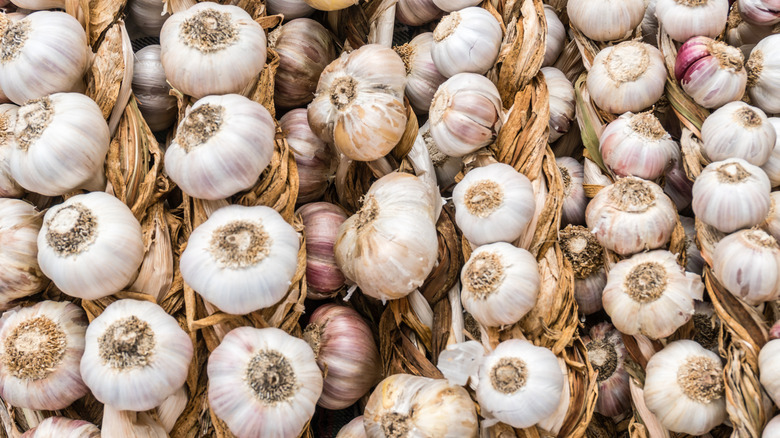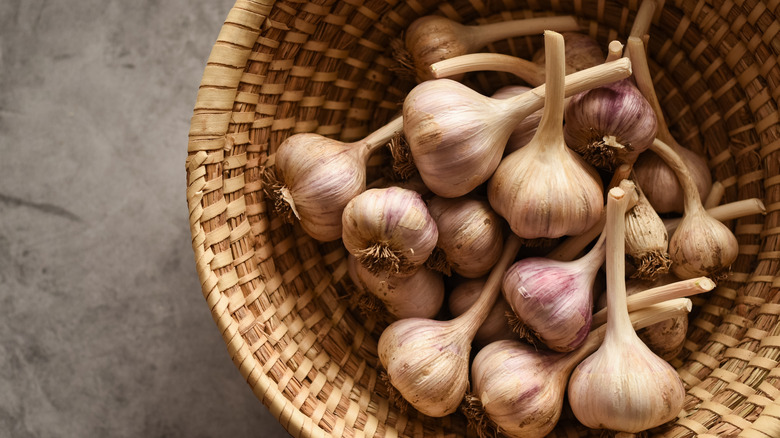What To Keep In Mind When Cooking With Hardneck And Softneck Garlic
Even though it's practically ubiquitous in savory dishes, cooking with garlic presents more complexities than you might realize. This beloved seasoning agent is available to purchase in many forms — as whole bulbs, pre-peeled cloves, diced and preserved in jars, or as a fine powder — but it always starts its life in the bulb state. Not all bulbs of garlic are identical, however. There are actually two groups of garlic varieties, hardneck and softneck, and though both of their plants are made up of cloves, they crucially differ in structure.
As the name implies, hardneck varieties of garlic have a hard stalk in their center, with cloves surrounding this stiff "neck." Softnecks, on the other hand, have a malleable stalk that won't even noticeably appear if you horizontally slice a bulb. They tend to grow in different climates and have different strengths and weaknesses when it comes to cooking. Even if you've never given garlic varieties any previous thought, learning how to distinguish between these two main types — and which is better suited for your kitchen — will take your culinary knowledge to the next level.
Softneck garlic is a grocery store staple
If you, like most of us, opt to buy your garlic from the grocery store rather than grow it yourself, chances are you've mostly encountered softneck garlic. It's the more common of the two groups by far, and is well-known for its long shelf life (which can be further extended in the freezer). Softneck garlic varieties grow best in warm climates with consistent moisture.
Softneck garlic cloves have a pleasant, mild flavor profile that is easily adaptable to most home-cooked recipes. Their skin is stickier in texture, and thus harder to peel than hardneck garlic cloves. Bulbs of softneck garlic also contain more cloves than hardneck varieties, typically sporting between nine and 16. Softneck garlic stalks are easy to braid because of their malleability, making these the primary plants used for beautiful and functional garlic braids. For a novice cook looking to give your dishes a mild yet distinct garlic flavor, or even for decorative purposes, softneck garlic is your best bet.
Hardneck garlic tends towards intensity
Though hardneck garlic varieties are less likely to be sold commercially, they're sometimes preferred by home gardeners, especially those in Northern climates. Hardneck garlic requires a period of cold exposure known as vernalization to grow and is generally more cold-hardy than softneck varieties. It's also considered especially easy to peel upon harvesting. However, hardneck garlic does not keep as well as softneck types, which is one of the reasons it's less likely to be mass-produced.
Though hardneck garlic bulbs contain fewer cloves, the cloves themselves are typically larger, with a more intense flavor and heat to them. Supposedly, gourmet chefs prefer to cook with hardneck varieties, especially when preparing dishes that invite robust, pungent flavors. The stem and flower of a hardneck garlic plant is called a garlic scape and is itself an edible delicacy prized by chefs. For bigger cloves and bigger flavor, it might just be worth locating or planting your own hardneck garlic. Keep in mind, though, that the variety of garlic you use is not the only factor affecting its flavor intensity — the way you cut it also plays a role.


